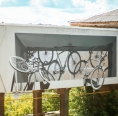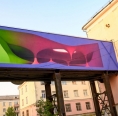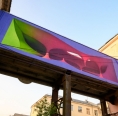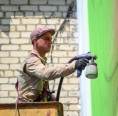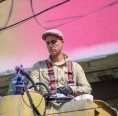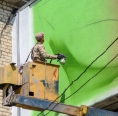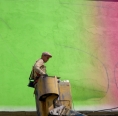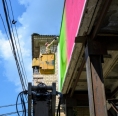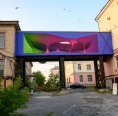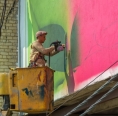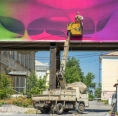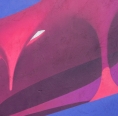-

MAGNÉTIQUE
-
Address:
-
Partners:
New 3D graphics, created by Moscow artist Danila Shmelev (Shozy) as part of the Satka Street Art Fest, is another experiment of the writer in an exceptionally bright color range. Unusual graffiti will become the hallmark of Art-Satka creative public space, which is being organized in the building of the YuURGU branch.
Not just bright but invigorating and magnetic
Today Danila finishes his work called Magnétique (magnetic or attractive). It became not only unique and experimental but also extreme for the artist. The rains interfered while the wall was being prepared, and as soon as Danila started working, abnormally hot weather began — the young man’s endurance can only be envied. This is an epic win over both — the circumstances and flat surface that disappeared under a spectacular optical illusion. The new art object was created on the second wall of the passage between the buildings of YuURGU (from the side of Metallurgov Street). On the backside of the passage, there are “hovering” bicycles painted by Danila last year in his characteristic 3D style.
- Danila, last time in your interview to Magnezitovets newspaper you noted that you love grayscale and monochrome drawing helps to focus on the shape. But you promised that, perhaps, on your next visit to Satka, you will create something bright. Is this the reason why your new work is so “explosive” both in colors richness and volume depth?
- There are already two works in Satka created by me in gray tones, it is dictated by the need not to drain focus from the shape of 3D drawing because of color. The organizers of the festival offered to do something bright this year because Art-Satka creative public space is being established in the building with which I work. And I decided to create not just bright, but invigorating work, with an almost nuclear effect — both in color and in shape. Usually, I have “chopped” geometry, but here I tried to create more amorphous shapes.
Initially, there was an idea to make a drawing in the style of a new series of works, which I began during quarantine (so far only in canvas format). These drawings resemble opal glass, behind which the volumetric figures “go” into the space depths or “come” from the inside, and this effect varies under different lighting conditions. That kind of project will be implemented in Tyumen, there will be a “square” on a 3-4-story building. And here, in Satka, it is a totally new work. I have never done this before, but this is also in my style and concept, only with blurring effect which is called “trompe-l'oeil” - a kind of “trick the eye” (from the French “tromp l`oel” — an optical illusion). This is an extensional 3D drawing that “goes” inward at an angle with the proper perspective and has volume. It results in the effect of space.
Satka's experiments
- You have also tried something new with "hovering" bicycles. You used light-reflecting paint. Are you offered to repeat that in other projects?
- Everybody likes bicycles! And though the works are always different, I continue to move and develop in my direction — in the 3D concept. And that is the style where I am looking for new specialties, bring to life new ideas. For example, it was here in Satka that I first used chrome while painting bicycles. It gives new possibilities — dynamics appears in drawings. I have used the same technique in Neftekamsk after the Satka experiment. The idea with chrome turned out to be even more advantageous there because the drawing was made on a tall building. This is a hive with bees, and on the top, there is a piece with chrome which reflects the dynamic sky, and because of this the picture changes during the day, it looks alive. So, chrome hit the spot with “a bang”.
- You have mentioned the planned project in Tyumen. It is clear that the coronavirus pandemic has made some adjustments, all plans have shifted, the deadlines have been compressed. But nevertheless, what are you planning to do over the summer and how did you manage to find time for Satka?
- I managed to come to you between events when there was free time. On the whole I am for any kind of movements and the possibility to put a new idea into life. Street-art festivals usually start in spring, but now everything has moved closer to the end of July. And the “field” work on walls is planned until the end of the summer. Mostly, I took projects in Russia, so as to try to get to Europe in the fall.
I am planning to have a vacation after Satka. Every year we go up north with friends. Usually, it takes two weeks of hiking and rafting in August, and this year we managed to set up in July. So I go straight to Moscow from you, a couple of days to get ready: we need to arrange equipment, boats, tents... After the trip, I am planning to go to Tyumen, and then to Chelyabinsk for the Culture Code Festival. I still need to finalize the sketch for it, because I originally made a project for 10 floors, and finally, there will be a wall of a 17-18 or 20-story building. My first “cross banner” (mural) will be in Chelyabinsk, but it is not my first work there. Five years ago, I took part in the decor process of the Museum of Illusions on Kirovka.
Essential meetings and art travelings
- You are for the third time in our city. What did the participation in our festival giver to you personally? Perhaps Satka "introduced" you to one of the artists or "pushed" you to new ideas?
- Yes! In 2018 on my first visit I met Hendrik Beikirch. It was a very essential meeting and communication. He even gave me important advice that I have been using ever since. This is a purely technical recommendation, but I myself have not reached it — you always learn something new from the artists of that level. Hendrik advised me to use a special accessory on the aerosol spray can (cap, they are different — thin, thick) in order to make a gradient (transition from one color to another). Usually, they use thick caps for this, especially if the gradient is wide, and they are smoothly sprayed, for example, a dark gray color, then lighter, even lighter. In this case, you do the spraying, the transition between colors by small dots, and they disappear gradually. And Hendrik suggested that for large gradients, for large cross banners, I can use a cap with a small tube. It gives crumbs, larger droplets and more spread, it turns out very neatly, and the color transition is smooth — a good effect, almost like from a paint-spraying gun. This is a purely technical moment, but it is precisely what is important in our work. Now, I use this cap for many other purposes because it has its own advantages, it is specific (therefore, it is rarely used), but very necessary!
I have known Lyosha Luka before our meeting in Satka. Last year, I met a French artist (Nebay) here. We managed to talk. He is a good guy and an interesting person.
This time, I work alone at the festival. Other artists will probably come later. However, I had this opportunity to see your town and district while they were preparing the wall. I visited the town two times, but I never had the chance to see something. I spent all the time working. This year, I managed to visit Ayskiye Prityosy, an old hydroelectric power plant in Porogi and Zyuratkul. I would like to thank everyone who organized this small and interesting trip.
- Street art is literally a trip to different cities and countries for an artist, and for viewers it is figuratively deemed to be a trip to contemporary art. Once you said that street art is good for small towns since every artist’s work is a dialog with a viewer. What is a new “dialog” with people living in Satka about? Which topics for “conversations” will we hear from you soon?
- A new work does not bind to anything and is not connected with anything. As I have already mentioned, Art-Satka Project influenced the choice of bright colors. This is just a new project for the town, a beautiful piece of area with unusual geometry. Anyway, street art always provokes a dialog with a viewer. Particularly, in small towns. As soon as a new work appears, people start discussing it. Of course, some locals will definitely say that they had better spend money on some other (more useful) things. However, the contemporary art is also important. Whether the contemporary art is understood or not, it provokes discussions, people start talking and thinking about it. In other words, it always unites, forms a new community, new views and opinions. Whether the discussion is positive or negative, anyway it provokes interaction which never existed before.
I accept some things in the contemporary art, but the others I do not. There are many artists that make beautiful paintings, but it is important to study and develop your skills. May be sometimes you should compromise. However, it is right to make something that people are not ready for. This is called progress. My task is to move forward and make progress in my 3D style. For example, last year in August I made an unusual work at the festival in Odintsovo. A plastic bag was somewhat stretched over the wall of a 20-story building. Some fragments were pulled out to form eyes and a mouth — kind of emoji. At the bottom of the wall, you can see people on a hanging stage who start covering the painting.
It is about disagreements between artists and locals, about the fact that some works are subsequently covered. Besides, it is about legalization of what we do, and creation of something new in a conventional environment. It should be done. Yes, it is a provocative act. It will be understood by a very small percentage of people. And most of them will likely agree to one of the comments that people now will have to live in a house with a plastic bag painted on it. No problems. More than 30 works were made during the festival, you can choose whatever you like and admire it. However, there will be no development in the place where nobody does unconventional things people are not ready for. It is for a reason that art is often compared with science which is also developing thanks for studies and new inventions. Street art should also be promoted. In Russia, there is such a conviction that painting on the walls is bad. However, in the Soviet time wall art was something normal.
Nature and Artist
- But back in those times, mosaic was more popular...
- Wall painting and mosaic as well. It is more permanent. In Moscow, you can see many mosaics of 60s. A mosaic, unlike paints which fade away, is preserved longer. Now, mosaic is becoming popular again. I would also like to create something in this style. But I have enough work now. My summer schedule is filled up, and unfortunately, I have to refuse to participate in some projects.
- It is even more valuable that you found time to come to Satka again. Thank you for the new work. I wish you luck in searching for something new and developing your own style. We will be waiting for new experiments!
- By the way, new things are not necessarily an experiment or something unique. Viewer’s psychology is characterized by searching old and familiar traits as well as recognizable images in new things... In this sense, pop art is easily and successfully understood. People see famous images, brands, cartoon heroes, etc. It is easier to understand. People like it more.
- What is “old and forgotten” in your new abstraction?
- It is impossible to make or create something totally new. Of course, I believe and hope that it is possible (smiling). There is always come kind of experience, a basis of or a reference to something that was created before the idea came to your mind. There are many 3D artists who made the same things, i. e. niches with 3D objects inside. The same principle I apply to bicycles. Besides, they are “exposed”. My new work has different shapes, and maybe they have something in common with those of muralism and digital art. I do not know what my new work may resemble to, but any shapes, even if they seemed to be new and unreal, are already created by nature. And if you search for them, you will be able to find them in the world around us.
Anna Filippova.
Photos by Vasily Maksimov and Denis Shakirov.
-
26.08 - 26.08
DIARY OF THE THIRD INDUSTRIAL BIENNALE
-
28.11 - 28.11
MY SATKA FESTIVAL WINS THE CONTEST OF CORPORATE VOLUNTEER PROJECTS
-
13.10 - 15.10
COOPERATION WITH VGIBL NAMED AFTER M.I. RUDOMINO

